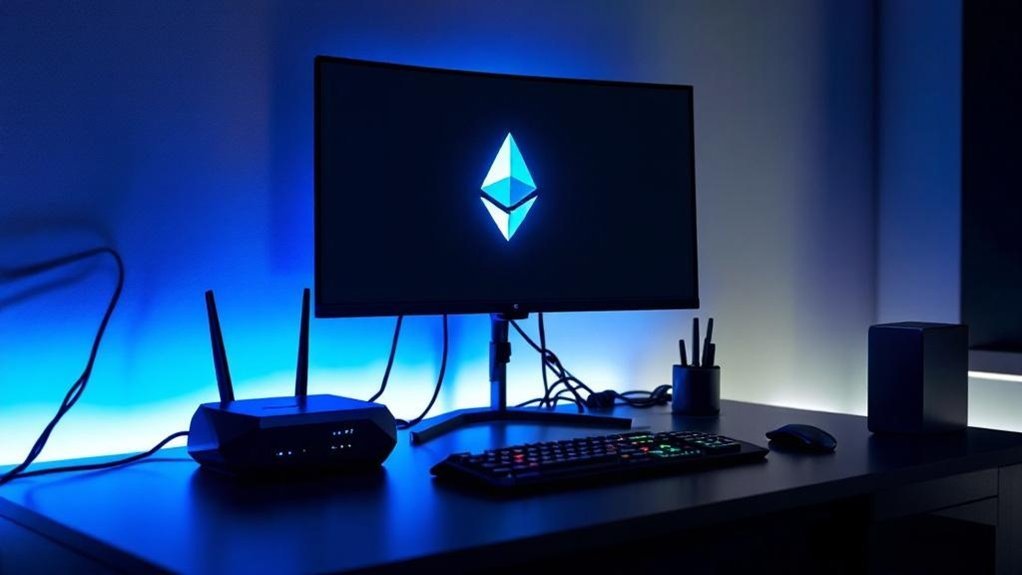To stake Ethereum 2.0, investors need 32 ETH and proper hardware setup – including 8GB RAM, quad-core CPU, and reliable internet. The process involves depositing ETH into the official contract and running validator software 24/7 to earn roughly 5.4% APR. Those without 32 ETH can join staking pools or use exchange services. Validators must follow network rules or face penalties. The technical details might seem intimidating, but the rewards make it worth exploring.

As Ethereum evolves into its next phase, staking has become the new way for users to participate in securing the network. The shift from proof-of-work to proof-of-stake means miners are out, and validators are in. No more massive energy bills or specialized mining rigs. Just pure, simple staking – well, sort of.
Getting started isn’t exactly a walk in the park. You’ll need 32 ETH to run a validator node. Yeah, that’s a pretty penny. The hardware requirements aren’t too shabby either: 8GB RAM, quad-core CPU, and SSD storage. Plus, you’ll need a rock-solid internet connection. Because downtime? That’s going to cost you.
The staking process itself is straightforward enough. Deposit your ETH into the official contract, set up your validator client software, and keep that node running 24/7. It’s like having a digital pet that needs constant attention – except this one actually pays you back. Centralized exchanges offer staking services that handle all the technical aspects for users. The process helps make the network more secure and decentralized. Similar to Cardano’s approach, the random selection process helps maintain network integrity and fairness. Speaking of payment, stakers are currently earning around 5.4% APR. Not too shabby for basically babysitting some software.
Don’t have 32 ETH lying around? No worries. Staking pools exist for the mere mortals among us. You can join forces with other users to meet the minimum requirement and share the rewards. There are also exchange services that handle all the technical stuff, but remember – not your keys, not your crypto.
The whole system relies on validators playing nice. Mess up or try anything funny, and you’ll get “slashed” – a fancy way of saying goodbye to some of your staked ETH. But play by the rules, and you’ll help secure the network while earning rewards. It’s a win-win situation that’s making Ethereum more energy-efficient and resistant to attacks.
The hardware setup isn’t rocket science, but it’s not exactly plug-and-play either. You’ll need to run client software like Lighthouse or Prysm, keep everything updated, and guard those validator keys like they’re the crown jewels. Because in the crypto world, they kind of are.
Frequently Asked Questions
What Happens to My Staked ETH if the Network Upgrade Fails?
If the Ethereum 2.0 upgrade fails, staked ETH remains permanently locked in validator contracts.
No withdrawals.
No rewards.
Nothing.
The funds stay frozen on the Beacon Chain until network consensus enables access – if ever.
While the ETH itself remains secure in smart contracts, its value could tank if upgrade problems persist.
Pretty grim scenario, honestly.
The community might eventually attempt rescue via hard fork.
Can I Stake ETH From a Hardware Wallet?
Yes, staking ETH from hardware wallets like Ledger is absolutely possible – and recommended for security.
These wallets let users generate deposit addresses and send their 32 ETH while keeping private keys safely offline. Pretty slick setup. Most hardware wallets integrate with staking interfaces and services, making the process straightforward. The big advantage? Those precious validator keys stay cold and secure, away from online threats.
Will Staking Rewards Be Taxable Income?
Staking rewards are absolutely taxable income.
The IRS treats ETH staking rewards as ordinary income at the time they’re received, based on the fair market value.
Pretty straightforward, really.
The timing can get messy though – especially with locked rewards.
And when those rewards are eventually sold?
That’s a whole different tax event.
Centralized exchanges might send 1099 forms, but the tax obligation exists regardless.
How Often Are Validator Penalties Applied for Being Offline?
Validator penalties hit like clockwork every epoch – that’s roughly every 6.4 minutes on Ethereum 2.0.
No breaks, no mercy.
The system checks each validator’s inactivity score and slaps them with penalties sized to match their laziness.
Even after getting back online, those pesky penalties keep coming until the inactivity score zeros out, which takes about 35 epochs minimum.
Brutal but fair.
Can I Join a Staking Pool With Less Than 32 ETH?
Yes. Staking pools make it easy to participate with way less than 32 ETH.
Some pools, like Rocket Pool, accept deposits as tiny as 0.01 ETH.
It’s pretty straightforward – pools combine everyone’s ETH to create full validator nodes.
No technical skills needed.
Popular options include Coinbase, Binance, and Kraken.
The trade-off?
Pools charge fees and hold onto your ETH until network unblocking.
